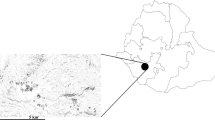Abstract
With diversification of field type among households in same eco-environment and social situation, even in the same ecosystem, merging household socio-economics with biodiversity initiative values to determine incentives and optimum strategy of on-farm conservation of biodiversity. Botany survey of agroecosystems at landscape level in Daka and Baka, Xishuangbanna, Yunnan, China, as well as household differentiation of biodiversity in agroecosystem and on-farm conservation strategy merging household socio-economic characters were studied. There were 73 families 179 species distributed in 0.1 ha of different agroecosystems in Daka, and 70 families 166 species distributed in 0.08 ha different agroecosystems of Baka respectively. The cosmopolitan families, such as Gramineae and Compositae decreased the percentage of tropical families and subtropical families. Botany survey among 12 random selected households from Daka in 46 sampling plots of different agroecosystems showed significant differentiation of the species richness indices of natural biodiversity and agrobiodiversity as there were differences of cognition and utilization of plant species besides management practices among households. Dengrogram using the Ward method of hierarchical cluster analysis based on annual questionnaire interview of 60% household from 1998 to 2001 in Daka showed disparity among different households’ socio-economics which underpins management diversity. There were significant correlation coefficients between household socio-economics and species richness indices of different agroecosystems. Fallow size had significant positive correlation coefficients with species richness index of rubber plantation. By contraries, production input had negative correlation coefficients with species richness index of upland rice field. Meanwhile, cereal crop income had significant positive correlation coefficient with agro-species richness index of rubber plantation. By contraries, other income such as off-farm income had negative correlation coefficients with agro-species richness index of rubber plantation. Innovations of the expert farmer on agrobiodiversity on farm conservation were admiration.
Similar content being viewed by others
References
Adhikari B., Di Falc S. and Lovett J.C. (2004). Household characteristics and forest dependency: evidence from common property forest management in Nepal. Ecological Economics 48(2): 245–257
Backes M.M. (2001). The role of indigenous trees for the conservation of biocultural diversity in traditional agroforestry land use systems: the Bungoma case study: in-situ conservation of indigenous tree species. Agroforestry Systems 52(2): 119–132
Brookfield H. and Padoch C. (1994). Appreciating agrodiversity: a look at the dynamics and diversity of indigenous farming systems. Environment 36(5): 6–11
Chunlin L., Heng L., Zhiqin O., Xiangyun Y., Qin L. and Bruce T. (2003). Strategies for agrobiodiversity and promotion: a case study from Yunnan, China. Biodiversity and conservation 12(6): 1145–1156
Coffey K. (2002). Quantitative methods for the analysis of agrodiversity. In: Brookfield, H. and Padoch, C. (eds) Cultivating Biodiversity – Understanding, Analysing and Using Agricultural diversity, pp 78–95. ITDG Publishing, London
Conelly W.T. and Chaiken M.S. (2000). Intensive farming, agro-diversity and food security under conditions of extreme population pressure in Western Kenya. Human Ecology 28(1): 19–51
Frei M. and Becker K. (2004). Agro-biodiversity in subsistence-oriented farming systems in a Philippine upland region: nutritional considerations. Biodiversity and Conservation 13(8): 1591–1610
Fujisaka S., Escobar G. and Jeneklaas E. (1997). Plant community diversity relative to human land uses in an Amazon forest colony. Biodiversity and Conservation 7(1): 41–57
Hardon-Baars A. (2000). The role of agrobiodiversity in farm-household livelihood and food security: a conceptual analysis. In: Almekinders, C. (eds) Encouraging diversity, pp 31–35. Intermediate Technology Publications Ltd, London
Huijun G., Zhiling D. and Brookfield H. (1996). Agrobiodiversity on the ground and among the people: methodology from Yunnan. PLEC News and Views 6: 14–22
Huijun G. and Zhenyu W. (1998). Agrobiodiversity. In: Huijun, G. and Chunlin, L. (eds) Biodiversity of Yunnan, SW China, pp 112–113. Yunnan Science and Technology Press, Kunming
Huijun G., Padoch C., Yongneng F., Zhiling D. and Coffey K. (2002). Household level agrobiodiversity assessment. In: Brookfield, H. and Padoch, C. (eds) Cultivating Biodiversity – Understanding, Analysing and Using Agricultural diversity, pp 70–77. ITDG Publishing, London
M. Keping. 1994. The measurement of community diversity. In: Biodiversity Committee of Chinese Academy of Sciences (eds). Principles and Methodologies of Biodiversity Studies. Chinese Science and Technology Press, Beijing, pp. 141–165
Mendez V.E., Lok R. and Somarriba E. (2001). Interdisciplinary analysis of homegardens in Nicaragua: micro- zonation, plant use and socioeconomic importance. Agroforestry Systems 51(2): 85–96
Montecinos C. and Salazar R. (2000). The CBDC programme: an experiment in strengthening community management of agrobiodiversity. Encouraging diversity 128(133): 128–133
Muller S. (2002). Diversity of management practices required to ensure conservation of rare and locally threatened plant species in grassland: a case study at a regional Sale (Lorraine France). Biodiversity and Conservation 11(7): 1173–1184
Pinedo-Vasquez M., Pasqualle J.B., Torres D.D.C and Coffey K. (2002). A tradition of change: the dynamic relationship between biodiversity and society in sector Muyuy, Peru. Environmental Science & Policy 5(1): 43–53
Rerkasem K., Yimyam N., Korsamphan C., Thong-ngam C. and Rerkasem B. (2002). Agrodiversity lessons in mountain land management. Mountain Research and Development 22(1): 4–9
Uppeti B.R. and Uppeti Y.G. (2002). Factors leading to agro-biodiversity loss in developing countries: the case of Nepal. Biodiversity and conservation 11(9): 1607–1621
Wood D. and Lenné J.M. (1997). The conservation of agrobiodiversity on-farm: questioning the emerging paradigm. Biodiversity and Conservation 6(1): 109–129
Yuming Y., Kun T. and Hao Jiming (2004). Biodiversity and biodiversity conservation in Yunnan, China. Biodiversity and Conservation 13(4): 813–826
Zapfack L., Engwald S. and Sonke B. (2002). The impact of land conversion on plant biodiversity in the forest zone of Cameroon. Biodiversity and Conservation 11(11): 2047–2061
Zarin D.J., Huijun G. and Enu-Kwesi L. (2002). Guidelines on the assessment of plant species in agricultural landscapes. In: Brookfield, H. and Padoch, C. (eds) Cultivating Biodiversity—Understanding, Analysing and Using Agricultural diversity, pp 57–69. ITDG Publishing, London
(1999). Analysis Methods on Social Statistics: Apply of SPSS Software. China Renmin University Press, Beijing
Author information
Authors and Affiliations
Corresponding author
Rights and permissions
About this article
Cite this article
Yongneng, F., Huijun, G., Aiguo, C. et al. Household Differentiation and On-farm Conservation of Biodiversity by Indigenous Households in Xishuangbanna, China. Biodivers Conserv 15, 2687–2703 (2006). https://doi.org/10.1007/s10531-005-6318-4
Received:
Accepted:
Published:
Issue Date:
DOI: https://doi.org/10.1007/s10531-005-6318-4




